Penicillin’s Eureka Moments: The Story of the Mold That Changed the World

Penicillin: A Medical History Landmark
The discovery of penicillin marks a pivotal moment in the history of modern medicine, fundamentally altering the treatment of infectious diseases.
Alexander Fleming’s Discovery
In 1928, Alexander Fleming, working at St. Mary’s Hospital in London, observed the inhibitory effect of Penicillium notatum mold on bacterial growth. This serendipitous observation led to the understanding of the mold’s antibacterial properties.
Impact and Development
Fleming’s discovery paved the way for the development of penicillin as a life-saving antibiotic. Its impact on treating bacterial infections was profound, significantly reducing mortality rates from previously untreatable diseases. Further research and development were crucial in refining penicillin’s production and effectiveness.
Penicillin in World War II
The use of penicillin during World War II dramatically demonstrated its life-saving potential. It played a crucial role in treating battlefield injuries and infections, contributing significantly to the Allied victory.
Conclusion
The discovery of penicillin stands as a testament to the power of scientific observation and its transformative impact on human health. It remains a cornerstone of modern medicine, highlighting the ongoing importance of research and development in combating infectious diseases.








